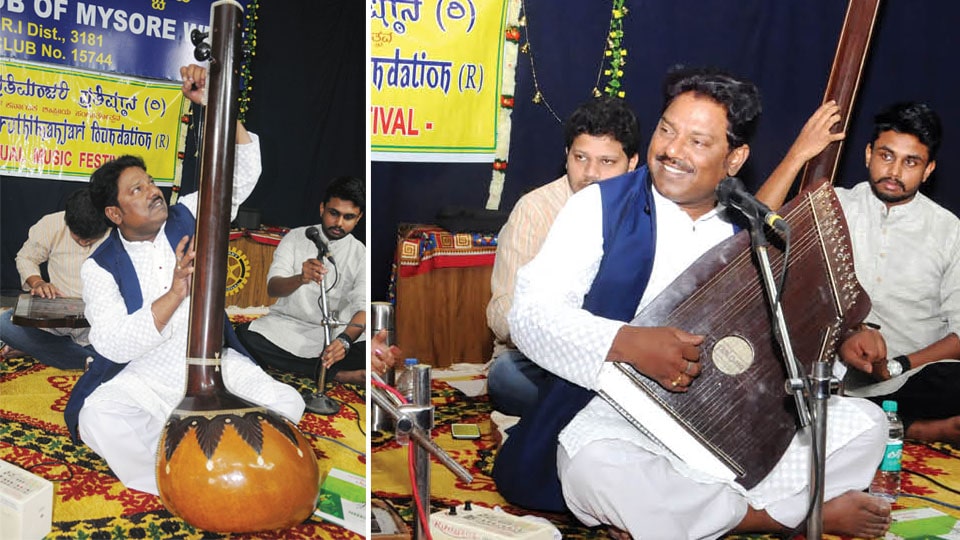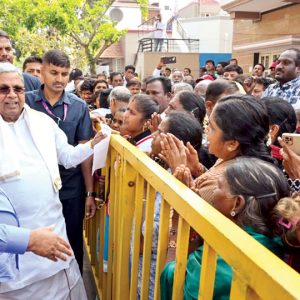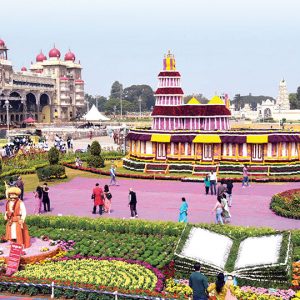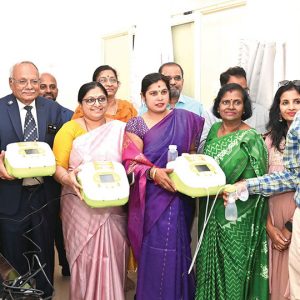By N. Niranjan Nikam
The world of music has produced some of the finest legends in the country in both Hindustani and Karnatak. Ustad Faiyaz Khan is one among them. He is one of the youngest persons to take over as the Chairman of Karnataka Sangeetha Nritya Academy. The versatile Sarangi player comes from a family of musicians dating back to eight generations.
Star of Mysore Features Editor N. Niranjan Nikam caught up with him during his recent visit to the city for a performance where he candidly spoke about his plans for the Academy, the ups and downs in life and the life-long learning of music.—Ed
Star of Mysore (SOM): Ustadji, it is about six months since you took office as the Chairman of Sangeetha Nritya Academy. How is the going so far?
Ustad Faiyaz Khan: There are a lot of big events happening. The Academy gave Kala Pratisthan Puraskar to musicians and we are also conducting Gadinadu Utsava (border festivals) in Bidar. We are giving scholarships to children and giving pensions to rural artistes. They get Rs.1,500 a month which is not much but it is something that will help them. We have six types of fields under the Academy like Karnatak, Hindustani, Sugama Sangeeta, Gamaka, Vyakhyana and Katha Keerthana (story telling). Then of course even the dance forms come under us.
In all these forms we provide scholarships and encourage them to grow. We do not see much of Gamaka and Vyakhyana in the State though we see them in Mysuru and a few other parts. However, this year we are giving it a lot of importance as they need to be developed. We will give Kalashree awards to both Gamaka and Vyakhyana artistes.
SOM: Your musical lineage spans over eight generations. Your grandfather was a famous Sarangi artiste in the courts of Maharaja of Mysore and the Nawab of Hyderabad. Have you heard any stories about his days in the Mysore Palace?
Ustad Faiyaz Khan: Even I am not too aware of this history. But my grandfather used to accompany Abdul Karim Khan. Even Pt. Bhimsen Joshi used to tell me about my grandfather. He used to come and stay in Mysore for weeks.
Nalwadi Krishnaraja Wadiyar who was the ruler at that time wanted to retain him in the Mysore Palace as this instrument was not there. He gave zameen (land) as inam (gift) in Shivamogga. Those days a lot of people would accompany him and they would stay there. My great grandfather’s wife was from that place. They had huge tracts of land. But my grandfather just left everything to his relatives and went back to Gwalior. We are originally from Gwalior.
How did we become Kannadigas? My grandfather who was travelling to Shivamogga died in a train accident near the city. However, my father and sister survived. My father Abdul Khadar Khan was 13-year-old. He used to accompany my grandfather. Then he lived in Shivamogga for a long time and worked in Gubbi theatre.
Akashwani was just then established. Those days jobs were offered on contract basis. As my father was struggling, he applied for a job as a Sarangi artiste in the 1950s and got the job in Dharwad All India Radio (AIR). Since it was a government job he came and settled down in Dharwad. My father was getting a salary of Rs. 8 or Rs. 10 a month. He used to tell me that in that salary he would take care of all of us six children and also save some money. I am the youngest in the family and I am the only one who has continued in music.
SOM: Sarangi resembles human voice and it is capable of reproducing human feelings and emotions, is what you have said. Can you enlighten?
Ustad Faiyaz Khan: First we have to see how close Sarangi is to the human voice. This is played using a bow like in violin but slightly heavy. Hence, we get continuity in swaras. But Sitar and Sarod are plucking instruments. In sitar they wear Mizrab to play the instrument, while in Sarod they use Jawa, which looks like a striker to play it. So, the sustenance that one finds in singing is not possible in these instruments as they have to keep stroking.
However, in Sarangi and other bow instruments, as long as the singer keeps the pitch, we can keep pace, since it is a bow instrument, the swara does not get cut. The second reason is the bow used in the Sarangi instrument is made out of the goat’s intestine. Hence, the sound is very close to human voice. Then there are no frets in Sarangi unlike in Sarod and Sitar and therefore we can produce the intonations in the voice of a singer as it is. Hence, all the nuances in the human voice we can produce in this instrument.
SOM: There was a personal tragedy when you lost your wife in a road accident. You sing Dasaravanis, which is very popular. Did these singings any way help you cope with this grief as Dasaravanis are full of meanings related to life?
Ustad Faiyaz Khan: My whole body was fixed with nuts and bolts after the accident. Even when the tragedy had not occurred I used to sing Dasaravanis. When I used to sing it before the tragedy, I used to put all emotions and sing them which were very meaningful and related to life. My style of singing became very popular as I gave a lot of importance to emotions and literature. But after the tragedy I automatically connected to it. I always tell artistes, if they understand the deeper meanings and remember the ups and downs in their lives, then in their music they can emote pain better. This is the connect I have with the divine and it can only be experienced.
SOM: You have worked with musicians like A.R. Rehman. What has been the experience like because he is also into mysticism?
Ustad Faiyaz Khan: I have worked with many musicians like Upendra Kumar Rajan-Nagendra, Vijay Bhaskar earlier and later with music directors like Hamsalekha. I also worked with Ilayaraja once. Then A.R. Rehman called me to do some work. More than a good experience, I can tell you that he is a very simple man. When a musician comes to him, he treats him very well without any ego. He always works at night, after 12. He called me to his studios at 12 midnight for recording. I had to play the Sarangi. He gave me the background to the song and asked me to play four or five pieces. ‘I will choose the one I like.’ It was probably for the movie Lagaan. I finished the work in 15 minutes. He said that this was more than enough.
What is to be noted here is that if the music director is very accomplished, he does not waste time. It is only the half-baked ones who make you do retakes just to show off before the producers that they have done some excellent work by squeezing the last drop out of the musician. But what actually happens is after so many retakes, they choose the one that is not so good leaving behind the best ones. But in case of Rehman I was very happy.
SOM: Ustad, you will be turning 50 next month. You are still very young. Where do you see yourself in the years to come?
Ustad Faiyaz Khan: My life has only been learning, listening and performing. Because I started accompanying some of the top artistes from the age of 11 like Ustad Bale Khan and his father Abdul Karim Khan and Pandit Basavaraj Raj Guru. There was no money those days but good listeners. Besides, Dharwad was a cultural hub like Mysuru.
I was born in Dharwad and lost my mother at the age of four. I can tell you the experience of living with a step mother. I learnt playing Tabla. People used to call me a child prodigy. I lost my father at the age of 16 or 17.
I wandered a lot in search of Gurus. I went to Benares, Bhopal and finally landed in Mumbai and under the guidance of Pandit Ramnarayan, I learnt and still learning from him. At the same time, a Palace singer from Kabul Mohammad Hussain Sarhan’s son Altaf Husain Khan who used to sing the Patiala Gharana style came to Mumbai. I learnt from him for two years. I learnt a lot from the gurus singing and playing Tabla and Sarangi. The learning is still continuing.
One good gift from God is he did not give me ego. I have become a good artiste and won several awards. I have never felt anything about my achievements because when we observe our legends, I feel what I am doing is still very little. I played with Rasik Lal Andharia, and listened to Bharat Ratna Bhimsen Joshi.
I have seen a lot of ups and downs in life. But I found a very good jeevan saathi (wife) Parveen Begum. Because of her presence, I was calm and peaceful. Even in difficult days, we used to live happily. There were a lot of changes for the better after she came into my life. Even Pandit Rajiv Taranath is our Guru. My younger son Faraz Khan is learning Sarod from him. My elder son Sarfarz Khan plays Sarangi.
SOM: If you don’t mind me asking have you not thought of marrying again?
Ustad Faiyaz Khan: No, no, only once, now it is over. I will tell you frankly. You must understand that I got a lot of love from my wife, more than I could ever bargain for—poora dil se. I can never forget her. If I marry somebody else then comparisons begin and I cannot give the same love. I do not want to put my children in a fix, may be, because of my own experience in childhood with my step-mother. Now I can at least sing in pain.
What God has given me in the first relationship is most sacred. My experience was heavenly. It is God’s will. He gave her to me and took her back. But other people might have different experiences. I like to share my knowledge with everyone unlike many great artistes who take their talent to their graves. We should be happy with our student’s progress and enjoy their success.
When I was in tenth I lost my father after that I could not pursue my studies because I could not get Rs.15 to pay for my hall ticket. I had lot of financial problems. But I never gave up practicing. When there was no place to practice, I have even gone to the graveyard and practiced.
I used to practice Sarangi and singing in my sister’s house after my father passed away. Once the neighbour came and admonished me. ‘What is this you are practicing the whole night and my children are not able to study.’ I asked him where could I go and practice. He said go to sudagadu (graveyard).’ I thought he has given me a good address. The very next day I went to the graveyard and used to practice till 2 in the night. I never felt any fear. After all they are very good people. They sleep peacefully.
After that I went to Hanumantha Rayara Gudi outside our city and then to Kalamma Gudi. We have what is called Chilla in our music. It is a penance. If we take a vow then we have to complete it. If we decide to practice for twelve hours, we have to do it. I have practiced for twelve hours for 41 days. I requested the priest at Kalamma temple to allow me to practice there. He gave the keys to us. I have done two Chillas, one in Hanumantha Gudi and the other in Kalamma temple.
SOM: Did you not experience any opposition for practicing in temples?
Ustad Faiyaz Khan: No. Even the priests did not object. If people question me then I have a very direct reply. I belong only to the caste of musicians and not to any caste. We belong to the Paigambari sect. At my home I light a lamp to Mehboobe Subani, which is our family God. I perform Saraswathi Puja also. It is something very private and personal.
Religion is for one’s own comfort, not to show off to anyone. I also used to go to the church and sit there in the evenings with my friend after finishing my afternoon Namaz. Everywhere there is joy and peace. All this caste and religion is bogus. I have asked people who have questioned me to learn either music or dharma. If you do not know both then do not dare ask me.








Recent Comments